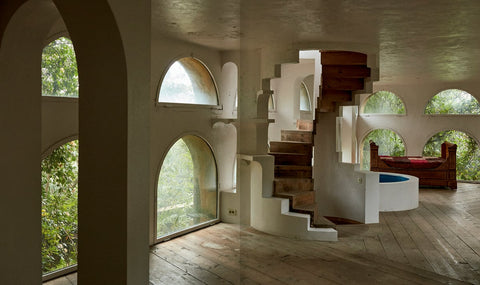PLACE
Espai Corberó: Another World
Where imagination, generosity, and poetry reign free
Imagery courtesy of Apartamento, Xavier Corberó and Daniel Riera
On the outskirts of Barcelona lies Espai Corberó, a surreal architectural labyrinth shaped by the late artist Xavier Corberó. It is a sprawling maze of towering arches, geometric voids, and floating staircases that go nowhere, evoking an Escher-like dreamscape. “This staircase goes somewhere,” Corberó once mused. “And it does a good job of going there. Who cares where it goes?”
Corberó liked dismissing logic. The Catalan sculptor has been called “the last of the surrealists” and “the new Gaudi”. What Corberó disliked was the label of “architect”. Espai Corberó is not a building. It is a world where imagination reigns free. He might have accepted being called “poet”; he told the filmmaker Albert Moya that he aimed to make all of his work—be they sculpture, buildings, or spaces—poetry. Corberó believed that poetry is “the measure of all things”.
The story of Espai Corberó began in 1968, when Corberó purchased a plot of land in Esplugues de Llobregat, a suburb of Barcelona. What started as a personal project evolved into an unending monument to creativity that was expanded and built continually for nearly five decades as Corberó acquired more land and buildings, including the heritage houses Can Cargol and Can Bialet, until the man passed away in 2017 at the age of 81.
At the end of his life, the sprawling compound encompassed eight interconnected buildings, 12 patios, 300 arches, and a subterranean theatre (which, reportedly, has excellent acoustics). At the heart of it all, stands a six-storey octagonal atrium shaft designed like a kaleidoscope—to play with light, a signature element of Corberó’s spatial manipulations.

Espai Corberó has been described as an inhabitable sculpture. But it is more than a mere collection of so many walls, archways, and staircases—fantastic as they are. “More than a house, it is a place, a place that has arisen from a total need: spiritual, emotional, physical,” Corberó said in an interview. It is not just a one-man utopia. It served as home, studio, workshop, and gallery not just for its creator. It was also a refuge that harboured artists-in-residents from all over the world. Espai Corberó was in fact quite the artistic commune, as many of Corberó’s creative friends, including Joan Miró and Elsa Peretti, came to visit, stay, and make work. It was reported that Corberó, who counted Salvador Dalí and Marcel Duchamp as friends, particularly cherished the art critic Robert Hughes and let him have his own bedroom in the main complex. Corberó described Espai Corberó as a “big space”, not so much in reference to its ever expanding boundaries but as a mental space or a state of mind, where creativity enjoys its freedom.

Those who had the pleasure of being taken on a tour of Espai Corberó in its heyday by the man himself would have stories to tell. On top of the theatricality of the space, they would have enjoyed their host’s showmanship. Corberó rigged the property with gadgetry and contraptions. These included hidden switches and buttons. When unsuspecting guests arrived at the quiet basin, he would flick the switch that would rumble then tumble a waterfall from overhead. There was another button that would open a wall to dramatically reveal a secret staircase. And then there was the alarm in the exceptionally slow-moving lift that Corberó liked to trigger—just to cause panic. Corberó enjoyed playing tricks with people–play is very much a part of this utopia, of this poetry, of this “big space” of Corberó's imagination, of his generosity.
The House of Xavier Corberó, a 224-page hardcover edited by his daughter Ana Corberó and put together by the team behind Apartamento, is the first publication to explore this home in Esplugues de Llobregat. It features original photography by Daniel Riera alongside a series of texts by long-time friends and colleagues of the artist.
The House of Xavier Corberó will be available at ANOTHER LAND soon.



